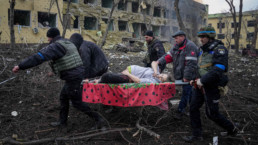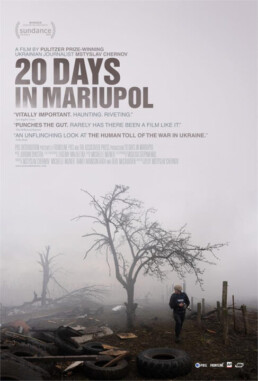20 Days in Mariupol
Filmed on the frontlines by an AP journalist, 20 Days in Mariupol is a brutal and sobering look at the early days of Russia's invasion.
A good documentary brings the viewer into a previously unknown world, introducing them to the subjects and situations from an unbiased point of view. At times, this intimate experience can prove to be a challenging watch, especially when human lives, including the filmmaker’s, are at stake. 20 Days in Mariupol is a brutal and sobering time capsule of the early days of Russia’s invasion of Mariupol, Ukraine’s Eastern port city.
Bringing this story to the world is Pulitzer Prize-winning AP journalist and Ukrainian filmmaker Mstyslav Chernov, who is credited as the documentary’s director, writer, and cinematographer. Immediately, we are transported to a ramshackle apartment building, with Russian tanks etched with the letter “Z” (signaling war) slowly encroaching into this previously quiet neighborhood. What follows is devastation of the highest degree: civilians are shot, the local hospital is under siege, and the harrowing realization that safety is fleeting.
Wearing a press badge as if it was a bulletproof vest, AP reporter Mstyslav Chernov uses a handheld camera to capture all of the events that unfold in Mariupol over the three weeks he is there. The footage he gets from being on the ground is directly sent to news outlets around the world, that is, when Russia doesn’t revoke internet access and make communication with the outside world impossible. The footage from Mariupol you saw on CNN, BBC, ABC, FOX, and more was captured by Chernov.

Throughout all of the chaos, Ukrainians are glad to have Chernov on site to show international news outlets the horrific nature of the war and Russia’s consistent killing of civilians. Chernov’s presence is invaluable, as he captures doctors frantically performing CPR on a four-year-old child who’s clearly dying, a father weeping over his sixteen-year-old son’s bloody body, his face so close that there’s a transfer of blood on his forehead, and devastated doctors crying underneath their N95 masks. “This is painful to watch, but it must be painful to watch,” says one Ukrainian police officer. This is the reality of life in Mariupol.
The filmmaking team could only withstand 20 days in the war-torn city before making a desperate decision to escape. It’s horrifying to discover that the war continued for another 60+ days after the AP reporters’ departure. What more destruction could Russian troops have possibly inflicted on this already depleted working-class town? One statistic displayed at the end of the film paints a stark picture of the community’s fate – a confirmed 25,000 people perished, with the actual number believed to be much higher.
20 Days in Mariupol feels unlike other documentaries in that it comes across as a true “journalists’ documentary”. Non-fussy title cards in Helvetica font display the necessary information; given that this is a PBS Distribution, and a FRONTLINE | PBS and The Associated Press-produced film, the intellectual tone that resonates with their online profiles rings true here. The score by Jordan Dykstra is very tense and often times it can be mistaken for wailing emergency alarms.
Haunting in the most extreme of ways, 20 Days in Mariupol also signifies the resilience of the community. The doctors, first responders, military, reporters, and citizens who open up their homes to strangers, all work together to keep any semblance of optimism alive. Mstyslav Chernov and all involved in helping tell this story should be lauded for their heroism and dedication to revealing one of the most important events in history.
Distributed by PBS Distribution. Opening at Film Forum in New York on Friday, 7/14, at Laemmle Monica in Los Angeles and Roxie Theater in San Francisco next Friday, 7/21.
Morgan Rojas
Certified fresh. For disclosure purposes, Morgan currently runs PR at PRETTYBIRD and Ventureland.


